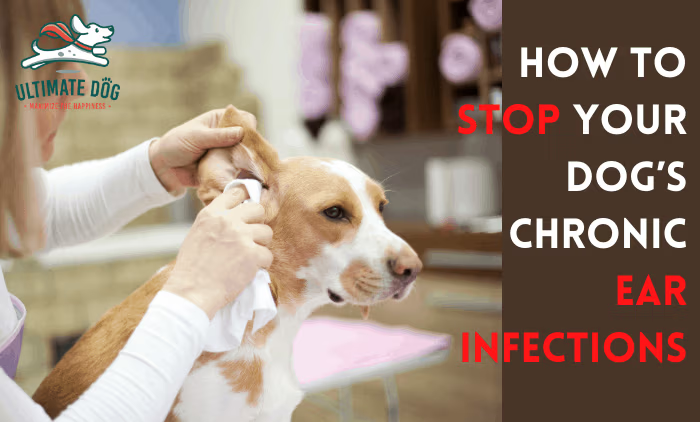There is nothing fun about watching your dog suffer through yet another ear infection. The constant scratching. The head shaking. The smell…
As troubling as it is to deal with a dog with an ear infection, we all know your pup has it worse. Ear infections are irritating at best and downright painful at worst.
If your pup is constantly battling ear infections, it is time to do something about it—to REALLY do something about it. This means addressing not just the pain and irritation you see on the outside, but fixing the cause of your dog’s chronic ear infections on the inside.
In this article, we’ll look at what really causes ear infections, how to address those causes to prevent future issues and walk you through some natural home remedies to treat your dog’s ear infection and help them find relief.
Dog Ear Infection Symptoms
Before we get into the nitty-gritty of what causes an ear infection, let’s make sure that is actually what your dog is suffering from.
First, it is important to know that there are different types of ear infections. The most common type affects the outer structures of the ear. With these, you might notice redness or swelling of the ear flap and scabby wounds on the inside of the ear flap.
Infection can also take hold in the middle and inner ear. With these types, you will typically notice a smelly discharge in addition to signs that your dog is uncomfortable. If left unchecked, these infections can quickly spread to the outer ear, causing additional pain and inflammation.
Here are some common signs your dog has an ear infection:
- Scratching or rubbing their ear
- Head shaking
- Tilting their head in one direction
- Whining when their ear is handled
- Red or scabby ear flaps
- Sour smelling reddish-brown discharge
- Green or yellow discharge
- Visible wax buildup
- Hair loss on the ear from excessive scratching
If left untreated, ear infections can progress and cause balance issues and hearing loss. If you notice any of these extreme symptoms or your dog is in a lot of pain, skip the natural remedies below and get your dog to the vet. Once your pup is feeling better, return to this article to begin addressing the root cause of your dog’s issues to prevent future problems.
A Quick Note on Aural Hematomas
One potential “side effect” of an ear infection is an aural hematoma.
If your dog is shaking their head or scratching excessively, it can damage the blood vessels inside the ear flap, leading to excess fluid buildup. You’ll be able to spot this condition immediately because your dog’s ear will puff up like a balloon.
This condition is not emergent, but can be very uncomfortable and will only increase how much head-shaking your dog does.
Unless you have dealt with aural hematomas before and know how to drain them yourself, you should take your dog to the vet to have the condition treated.
Some vets will recommend “quilting” your dog’s ear using multiple sutures to hold the walls of the flap together after the ear is drained. While this may be necessary for dogs that chronically suffer from this condition, it is usually not required for first-timers.
With a lot of care and attention and plenty of warm compresses, it is possible to encourage a drained aural hematoma to heal on its own without excess scar tissue.
What Causes Dog Ear Infections?
Ear infections come in many flavors. They can be caused by bacteria, yeast, or mites. Or the original cause may have been a foreign body that has led to a secondary infection. Each ear infection type looks a bit different and may require different treatments.
Yeast
Ear infections caused by yeast are the most common in the doggy kingdom.
Yeast lives in basically every part of the body, including inside the ear and on the skin of the ear flap. In normal amounts, yeast is beneficial. But in higher than normal amounts, they can quickly cause problems.
The easiest way to distinguish a yeast ear infection from other types is by assessing the discharge. Yeasty discharge is reddish brown with a sour smell (think sourdough bread or beer brewery).
Yeast infections spread fast, so you are also likely to see the outer structures of the ear affected. Irritated, crusty skin on the ear flap is a good indication you are dealing with yeast overgrowth in the ear.
Bacteria
Like humans, dogs are also prone to bacteria-caused ear infections. Typically, these infections start in the inner or middle ear. They may spread to the outer ear, especially if treatment or system imbalances cause yeast overgrowth to occur as well.
Signs of a bacterial ear infection include yellow or green discharge, a foul odor, and increased sensitivity to the handling of the ear or head.
While yeast infections tend not to be painful at first, pain is often the first sign of a bacterial infection.
Foreign Object
If your dog has long, floppy ears and likes to play in the field or the dirt, it is very possible that a foreign object could be the underlying cause of their ear infection.
Grass seeds, splitters, and even dirt can embed themselves in your dog’s ear canal, causing pain and irritation. If left untreated, a bacterial infection is likely.
If you suspect a foreign object is the cause of your pup’s problems, get them to the vet right away to be checked out.
Ear Mites
Another common cause of ear infections in dogs is ear mites.
These tiny parasites feed on the wax and oils in your dog’s ears. In the process, they can really irritate your pup, leading to head shaking and scratching. While the bugs themselves don’t bite your dog or cause injury, all that itching can. Your dog may even bug their ears enough to cause a secondary bacterial infection.
Aside from the constant head shaking and scratching, the clearest indication of a mite infection is the presence of coffee-ground-like residue in the folds of your dog’s ears.
To get rid of ear mites, use the mullein and garlic oil treatment outlined below with some olive oil added as well. The garlic and mullein are antiparasitics, and the additional olive oil will help asphyxiate any bugs that survive. Repeat every three days for about two weeks.
Be sure to treat both ears and monitor the other pets in your house as ear mites spread quickly.
The Whole Picture: What Really Causes Dog Ear Infections
Yeast, bacteria, and mites all technically cause ear infections, but they aren’t the root of the problem. They are simply opportunists that set up in environments that have been compromised by other factors.
A healthy dog has many defenses against ear infections. The yeast in their bodies works with them and is balanced by probiotic activity. Invasive bacteria are quickly dealt with by a robust immune system. And mites struggle to establish thanks to a multitude of defenses.
If your dog deals with chronic ear infections, the problem likely does not lie in its ears. To help put a stop to this recurring problem, you’ll have to look much deeper.
Problems in the Gut
Almost 70% of your dog’s immune system is housed in its gut. So, it makes sense that if your dog is struggling with infections, the problem might be rooted here.
Beneficial microorganisms called probiotics live by the billions in a healthy gut. These helpful microbes serve as a direct line of defense against harmful pathogens that enter the body through the mouth.
They also communicate directly with the immune system to let it know about changes in the outside world and within the body itself. If a certain bacteria or virus is detected in the gut, chemical signals from helpful bacteria will encourage the immune system to create more cells of the type needed to defeat that pathogen.
Scientists are only now beginning to understand all the amazing ways the gut is connected to the immune system.
But one thing we have known for a while is that an unhealthy biome in the intestines is directly related to chronic illness in the body. Including chronic ear infections.
Diet
One thing that has a huge impact on the gut biome is a dog’s diet.
Your pup evolved to get almost all of its nutrients from meat, fat, and bone. But most of today’s domestic canines eat more carbohydrates than anything else. This has a profound impact on your dog’s probiotic load and immune system.
Add to this excess of carbs a multitude of preservatives, chemicals, and pesticides, and you have a recipe for disaster.
Dogs on low-quality, carbohydrate-loaded food are much more likely to suffer from chronic ear infections than dogs on high-quality, protein-based diets.
Allergies
Allergies, whether to food ingredients or environmental irritants, can put an excess strain on the immune system. As the immune system weakens from constantly reacting to allergens, pathogens can grow out of control.
Food allergies are especially likely in dogs that have chronic ear infections. The combination of an exhausted, out-of-balance immune system and a gut tormented by allergen-induced inflammation, creates the perfect environment for yeast to take over.
Yeast infections in the ear are often a sign of systemic yeast overgrowth. This overgrowth starts in the gut and extends outward through the soft tissues of the digestive, reproductive, urinary, and respiratory tracts, eventually making it all the way to the outer ear.
Leaky Gut
Chronic inflammation in the intestines caused by food allergies and unbalanced biomes can also lead to a condition known as a leaky gut syndrome.
The intestines’ job is to form a tight barrier between digesting food and the body’s bloodstream. Only tiny nutrients are allowed to pass through into the body. But when this barrier loosens or forms gaps, larger particles like food, pathogens, and toxins are able to move through.
This causes a host of problems throughout the body, including malnutrition, inflammation, and chronic disease. One of the simplest indicators of leaky gut is chronic ear infections.
A number of conditions can lead to leaky gut, including unchecked food allergies, probiotic imbalances, poisoning, and poor diet.
Immune System Issues
Anything that negatively affects the gut will have a negative impact on the immune system. But dogs with pre-existing immune issues are also at risk of developing chronic ear infections.
If your dog suffers from a known immune system problem, such as an autoimmune disease or hereditary immunodeficiency disorders, it is extra important to support their gut biome and overall health to keep chronic infection at bay.
Certain medications can also cause immune suppression. These include things like antibiotics and steroids–two common treatments for ear infections. If you’ve taken your pup to the vet for their ear infections in the past, the medications used to treat their symptoms may very well be part of the reason those ear infections keep coming back.
Floppy Ears
The last condition that is often associated with chronic ear infections is one that you can’t really control.
Dogs with floppy ears, such as hounds and spaniels, are naturally more susceptible to infections in their ears because of the shape of the ear itself. That heavy ear flap creates the perfect, moist, dark environment for bacteria and yeast to flourish. Dogs that swim a lot are also more likely to get infections because their ears stay damp for extended periods.
Having a dog with floppy ears just means that you need to be extra vigilant about maintaining their immune system and gut health so that they can fight any pathogens that do try to take up residence in those adorably floppy ears.
How to Treat Dog Ear Infections Naturally
For all the reasons listed above, dog ear infections often need to be treated in two ways. If your pup is showing many outward symptoms, such as pain, swelling, and intense scratching, treating the symptoms themselves is vital. But you must also reach beyond the obvious cause of their discomfort and treat the root of the problem.
First, we’ll show you how to treat a dog ear infection without a vet.
How to Treat the Symptoms
The ear is a delicate feature. The skin inside is fragile and prone to damage. The ear has its own little microbiome that can be thrown out of whack quite easily. For these reasons, treating the ear itself isn’t always the best approach. If you can instead treat only the root cause, minor ear infections will clear up on their own.
However, if your dog is very uncomfortable, if there is a lot of swelling, or if multiple ear parts are affected, treating the symptoms will be just as important as treating the cause. Here are six proven home remedies for dog ear infection treatment.
Garlic and Mullein Oil
This is one of the best remedies for dog ear infections that you can put together at home.
Both mullein and garlic have strong antibiotic properties. In oil form, they are effective against both bacterial and yeast ear infections. You can purchase mullein oil at your local health food store. Mix a few drops with one drop of garlic oil, or place a small clove of garlic in the mullein oil and allow it to sit for a week or two.
Place a few drops in the affected ear canal and massage gently every day until symptoms ease.
Apple Cider Vinegar
Another compound with strong antibiotic properties is apple cider vinegar. This dog ear infection home remedy also works as an astringent to clean excess discharge and wax from the ear canal.
Soak a cotton ball in a half-vinegar, half-water solution and place it just inside your dog’s ear canal. Massage the ear gently, then pull the cotton ball out. Repeat until the cotton ball comes out relatively clean. Once the gunk has been removed, the other treatments on this list will be more effective.
Grapefruit Seed Extract
In addition to being antibacterial and antifungal, grapefruit seed extract is a powerful antioxidant. It encourages healing and balance in the ear. Best of all, this extract can be used topically or orally, which means your dog can get the benefits even if they won’t let you handle their ear.
To make a topical solution:
- Mix about ten drops with one tablespoon of pure aloe vera juice.
- Use this cleanser the same way you would clean your dog’s ears with vinegar.
- As an oral treatment, add a few drops to their food each day.
Green Tea
Green tea is another powerful antioxidant that can effectively reduce inflammation and encourage healing. And it can be made at home with very little work. To create your own green tea treatment, boil one cup of water and steep two bags of natural green tea. Once the liquid has cooled, clean the ear as you would with vinegar.
Oregano Oil
Oregano oil is a powerful antibacterial and a great choice for stubborn bacterial ear infections. Add a couple of drops of this potent oil to one tablespoon of pure aloe vera juice. Use a cotton ball to gently roll the mixture over all exposed areas of the ear flap and just into the inner ear.
Calendula Cream
If your dog is suffering from an uncomfortably itchy ear, calendula cream can help. This plant extract is naturally soothing and pain-reducing. Spread it over your dog’s ear flap to reduce redness and inflammation. You can also buy it in tincture form, mix a few drops with half a cup of water, and clean the ears as you would with vinegar.
How to Treat the Cause
Treating the symptoms of your dog’s ear infection may help them feel better, but treating the root cause is far more important in the long run.
There isn’t much you can do to change the shape of your dog’s ears or cure them if they’ve been living with a long-term medical condition that affects their immune system. But by addressing the quality of their diet, removing allergens from their bowl, and improving their gut health, you can significantly reduce the odds of repeat infections, even in the face of other complicating factors.
By addressing what caused the infection, you can help your pup avoid painful and itchy ears in the future (and improve their overall health).
Improve Your Dog’s Diet
Eating a low-quality, biologically inappropriate diet has a myriad of effects on a dog. By improving your pup’s diet, you are taking the first step to improving their overall health.
Dogs have evolved with a stomach and gut meant to digest and utilize the same foods their wild cousins eat. In order to get all the nutrients they require and to maintain a balanced system, they need plenty of quality animal protein and fat and limited carbohydrates.
The healthiest diet for our companion dogs is a raw food diet. Meaty bones, organ meat, and muscle provide almost everything your dog needs to thrive. Add to that a minimal amount of non-starchy vegetables, and you have a complete meal and a happy pup.
If raw food (commercial or homemade) is not an option, quality dehydrated or freeze-dried food is the next best thing. After this, natural, high-protein canned food is the best option, followed by high-protein kibble that utilizes animal-sourced primarily ingredients.
A quality diet builds the foundation of good health and strengthens your dog’s entire system to help keep ear infections at bay.
Check for Food Allergies
Not even a high-quality diet can improve your dog’s health if they are allergic to one of the ingredients in it. If this is the case, your dog will still experience inflammation, imbalance, and leaky gut symptoms, despite getting all the right nutrition.
To reduce all these nasty processes that can also put your dog at risk for chronic ear infections, you need to completely eliminate the allergen from your dog’s diet.
If you don’t know exactly what your dog is allergic to, you’ll have to go through the process of an exclusion diet to figure out which ingredient (or ingredients) your dog is reacting to. This is a long process that requires some work, but it is worth it to naturally remove the cause of all that itching and pain from your dog’s routine.
Once the allergen is no longer a factor, there will be less inflammation and your pup’s immune system will get stronger. And problems like ear infections will noticeably diminish.
Improve Your Dog’s Gut Health
Removing allergens from your dog’s bowl and feeding a quality diet will help to reduce ear infections by allowing balance to be restored to your dog’s body. Most specifically, these things help restore balance to the gut.
The rehabilitation of your dog’s microbiome can take time, especially if they have been experiencing digestive inflammation due to allergies and poor diet for years. But there is something you can do to help the process along.
Probiotic supplements provide a direct line of good bacteria to your dog’s system to help speed the recovery process. But not all probiotics are created equal. Certain strains and types are more likely to survive the stomach’s acidic environment and establish in the intestines where they are needed.
If your pup suffers from chronic inflammation, digestive trouble, or chronic ear infections, adding something like our CHIRP Superfood Topper to their routine can make a huge difference.
In addition to high-quality and effective probiotics, this tasty topper includes nutrient-dense cricket protein, prebiotic chitin and digestive enzymes, and soothing reishi mushroom powder. All of these ingredients work together to improve your dog’s gut health and strengthen its immune system.
Prepare for Better Days
Combined with a high-quality, allergen-free diet, a premier probiotic supplement like our CHIRP Superfood Topper will help your pup heal. The frequency of your dog’s ear infections will diminish exponentially as their gut balance is restored, inflammation is reduced throughout the body, and their immune system grows stronger.
This process may take a little time, especially if you are battling food allergies, but it is well worth following through on. Odds are, once your dog has recovered, you’ll realize that ear infections weren’t the only issue plaguing your pup due to an imbalanced biome.
With a little dedication, your pup will soon be back to the happy, healthy, and ear-infection-free pooch you used to know.
Sources
Boulder Holistic Vet. (2019, December 23). 3 Reasons Your Pet Gets Ear Infections and How to Stop Them. https://boulderholisticvet.com/3-reasons-your-pet-gets-ear-infections-and-how-to-stop-them/
Central Texas Veterinary Specialty & Emergency Hospital. (n.d.). How to Spot an Ear Infection In Your Dog. CTVSH. Retrieved March 9, 2021, from https://www.ctvsh.com/services/dogs/blog/how-spot-ear-infection-your-dog
FRASER, G., WITHERS, A. R., & SPREULL, J. S. A. (1961). Otitis Externa in the Dog. Journal of Small Animal Practice, 2(1–4), 32–47. https://doi.org/10.1111/j.1748-5827.1961.tb04080.x
Kowalski, J. J. (1988). The Microbial Environment of the Ear Canal in Health and Disease. Veterinary Clinics of North America: Small Animal Practice, 18(4), 743–754. https://doi.org/10.1016/s0195-5616(88)50077-3
Weir, DVM, MSc, MPH, M., & Ward, DVM, E. (n.d.). Ear Mites in Cats and Dogs. VCA. Retrieved March 9, 2021, from https://vcahospitals.com/know-your-pet/ear-mites-otodectes-in-cats-and-dogs

Sara Seitz worked in the pet industry for over a decade. In addition to being a certified dog trainer, Sara gained experience working as the general manager of a dog daycare and boarding facility, as the creator and manager of a pet sitting company, as a groomer, and as a dog behavior evaluator. She also has a bachelors in animal behavior from CSU. Currently, Sara works as a freelance writer specializing in blog, article and content writing.





Leave a Comment